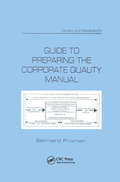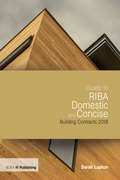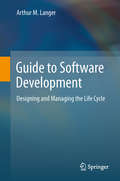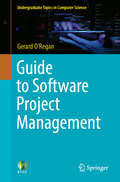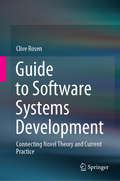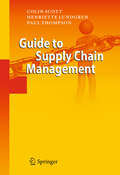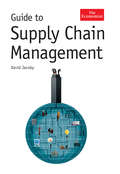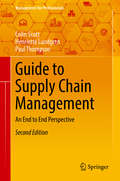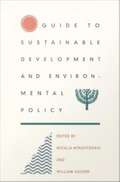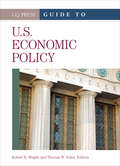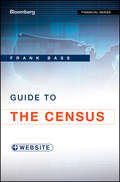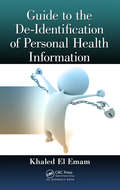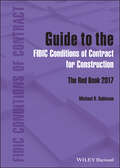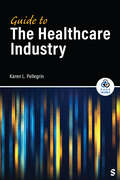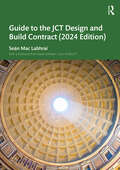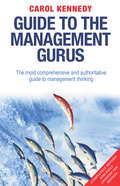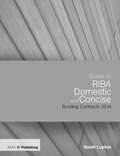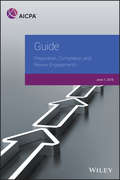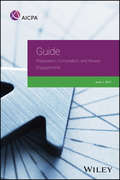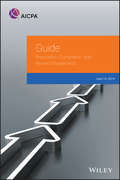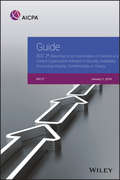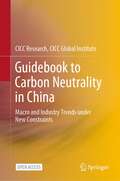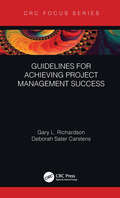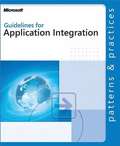- Table View
- List View
Guide to Preparing the Corporate Quality Manual (Quality And Reliability Ser. #51)
by Bernard FromanUtilizes advanced concepts, guidelines and requirements from the latest ISO 9000 and 10000 series of standards, as well as other models, including TQM (Total Quality Managment). The text shows how to define a policy and explain it clearly. It offers procedures for developing a quality manual, to be used by personnel performing quality-related functions and for external auditors and customers.
Guide to RIBA Domestic and Concise Building Contracts 2018
by Sarah LuptonThis latest title from the author provides comprehensive guidance to RIBA's two updated building contracts: the RIBA Domestic Building Contract 2018 and the RIBA Concise Building Contract 2018. Introducing the contracts' features and benefits and covering all aspects of their use, from choosing and forming the right one for your project to guiding the parties through all its various stages, the Guide has been expanded with increased assistance on choice of form, tendering and contract formation. Additional detail on role and liabilities of contract administrator has been added, along with a new section on practical completion and completion, including certification. Assuming no current knowledge of the law or contract administration, this acts as a standalone guide for new users of the RIBA contracts, as well as a valuable update for previous users. It is an ideal companion for anybody using the latest building contracts.
Guide to Software Development
by Arthur M. LangerThis book addresses how best to make build vs. buy decisions, and what effect such decisions have on the software development life cycle (SDLC). Offering an integrated approach that includes important management and decision practices, the text explains how to create successful solutions that fit user and customer needs, by mixing different SDLC methodologies. Features: provides concrete examples and effective case studies; focuses on the skills and insights that distinguish successful software implementations; covers management issues as well as technical considerations, including how to deal with political and cultural realities in organizations; identifies many new alternatives for how to manage and model a system using sophisticated analysis tools and advanced management practices; emphasizes how and when professionals can best apply these tools and practices, and what benefits can be derived from their application; discusses searching for vendor solutions, and vendor contract considerations.
Guide to Software Project Management (Undergraduate Topics in Computer Science)
by Gerard O'ReganThis essential textbook presents an overview of software project management in an ethical and responsible software engineering environment. The book covers the essentials of software project management, and highlights the importance of ethics and professional responsibility as part of the skill set of the modern project manager. Topics and features: Presents a solid overview of software project management Discusses professional and ethical responsibilities of project managers Presents an overview of ethical software engineering Reviews project planning and scheduling, project monitoring and control, risk management and project closure Discusses quality management of software projects Presents an overview of legal and ethical aspects of outsourcing Discusses project management for both traditional and Agile projects Reviews a selection of tools & metrics to support project management Discusses best practice (Prince 2, PMP and CMMI) to improve project management Includes key learning topics, summaries, and review questions in each chapter, together with a useful glossary This practical and easy-to-follow textbook/reference is ideal for computer science students seeking to understand software project management. The text also serves as a self-study primer for software engineers, project managers and software managers. Dr. Gerard O’Regan is an international lecturer in Maths/Computing with research interests in software quality, software process improvement, mathematical approaches to software quality, and the history of computing. He is the author of several books with Springer, including Concise Guide to Software Engineering, Ethical and Legal Aspects of Computing, and A Brief History of Computing.
Guide to Software Systems Development: Connecting Novel Theory and Current Practice
by Clive RosenThis book argues that the key problems of software systems development (SSD) are socio-technical rather than purely technical in nature. Software systems are unique. They are the only human artefacts that are both intangible and determinant. This presents unprecedented problems for the development process both in determining what is required and how it is developed. Primarily this is a problem of communications between stakeholders and developers, and of communications within the development team. Current solutions are not only inadequate in expressing the technical problem, they also evade the communications problems almost entirely.Whilst the book addresses the theoretical aspects of the process, its fundamental philosophy is anchored in the practical problems of everyday software development. It therefore offers both a better understanding of the problems of SSD and practical suggestions of how to deal with those problems. It is intended as a guide for practising IT project managers, particularly those who are relatively new to the position or do not have a strong IT development background. The book will also benefit students in computing and computer-related disciplines who need to know how to develop high quality systems.Software systems development (particularly of large projects) has a notoriously poor track record of delivering projects on time, on budget, and of meeting user needs. Proponents of software engineering suggest that this is because too few project managers actually comply with the disciplines demanded of the process. It is time to ask the question, if this is the case, why might this be? Perhaps instead, it is not the project managers who are wrong, but the definition of the process. The new understanding of the SSD presented here offers alternative models that can help project managers address the difficulties they face and better achieve the targets they are set. This book argues that time is up for the software engineering paradigm of SSD and that it should be replaced with a socio-technical paradigm based on open systems thinking.
Guide to Supply Chain Management
by Paul Thompson Colin Scott Henriette LundgrenThis guide brings supply chain theory to life. Written for people with a business interest in supply chain management, the book covers the key topics in eleven chapters, including plan, source, make, deliver and return as well as strategy, people, finance, customer service and outsourcing. Each chapter starts with a brief summary and learning objectives that guide the reader through the text. The book is written in a clear and simple way, featuring a variety of figures, tables and recommended further readings. The chapters conclude with real-life case studies for best practice. During their work, the authors have met professionals all over the world who are passionate about their business achievements. By including their vivid examples, the guide brings theory to life enabling readers to understand the concepts and ideas presented in the guide. Colin Scott, Henriette Lundgren and Paul Thompson are experts in supply chain management and have worked with practitioners in businesses across the globe. "This guide is a really useful reminder of what good practice is and how it should be applied within supply chain management. The book is relevant for students of supply chain management and professional practitioners alike. This book offers an invaluable guide to understanding the specific dynamics of your supply chain and the fundamentals underpinning it. It provides the framework for delivering a supply chain strategy based upon recognised best practice." Martin McCourt, CEO, Dyson Limited
Guide to Supply Chain Management (Economist Books)
by David JacobyGlobalisation, technology and an increasingly competitive business environment have encouraged huge changes in what is known as supply chain management, the art of sourcing components and delivering finished goods to the customer as cost effectively and efficiently as possible. Dell transformed the way people bought and were able to customise computers. Wal-Mart and Tesco have used their huge buying power and logistical skills to ensure the supply and stock management of their stores is finely honed. Manufacturers now make sure that components are where they are needed on the production line just in time for when they are needed and no longer. Such finessing of the way the supply chain works boosts the corporate bottom line and can make the difference between being a market leader or an also ran. This guide explores all the different aspects of supply chain management and gives hundreds of real life examples of what firms have achieved in the field.
Guide to Supply Chain Management: An End to End Perspective (Management for Professionals)
by Paul Thompson Colin Scott Henriette LundgrenThis essential guide brings supply chain theory to life. Intended for readers with a business interest in supply chain management, the book covers the key topics in eleven chapters, including planning, sourcing, making, delivering and returning, as well as strategy, people, finance, customer service and outsourcing. Each chapter starts with a brief summary and learning objectives that guide the reader through the text. This second edition also explores digital, sustainability and innovation impacts on today’s global supply chains.The book is written in a clear and simple way, featuring a variety of figures, tables and recommendations for further reading. The respective chapters conclude with real-life case studies from different companies, illustrating best practices.In the course of their work, the authors have met professionals all over the world who are passionate about their business achievements. By including their vivid examples, the guide brings theory to life, enabling readers to understand and embrace the concepts and ideas presented. Colin Scott, Henriette Lundgren and Paul Thompson are experts in supply chain management and have worked with practitioners in businesses across the globe.Endorsement:This guide is a really useful reminder of what good practice is and how it should be applied within supply chain management. The book is relevant for students of supply chain management and professional practitioners alike.This book offers an invaluable guide to understanding the specific dynamics of your supply chain and the fundamentals underpinning it. It provides the framework for delivering a supply chain strategy based upon recognised best practice.Martin McCourt, CEO, Dyson Limited.
Guide to Sustainable Development and Environmental Policy
by Natalia Mirovitskaya William AscherThe Guide to Sustainable Development and Environmental Policy is a comprehensive presentation of definitions, philosophies, policies, models, and analyses of global environmental and developmental issues. With a wealth of comparative, multidisciplinary, and geographically varied perspectives on environmental governance, it also provides detailed and balanced discussions about specific environmental issues. The guide combines formal, objective entries with critical commentaries that emphasize different opinions and controversies. With succinct explanations of more than a thousand terms, thoughtful interpretations by international experts, and helpful cross-referencing, this resource is designed to serve as a roadmap for understanding the issues and debates in the overlapping fields of environment and development. Intended for use by activists, journalists, policymakers, students, scholars, and interested citizens, the Guide to Sustainable Development and Environmental Policy will be a helpful tool for anyone trying to get a comprehensive look at the many environmental organizations, schools of thought, development programs, international environmental treaties, conventions, and strategies that have proliferated in the past few decades.
Guide to U.S. Economic Policy
by Robert E. Wright Thomas W. ZeilerGuide to U.S. Economic Policy shows students and researchers how issues and actions are translated into public policies for resolving economic problems (like the Great Recession) or managing economic conflict (like the left-right ideological split over the role of government regulation in markets). Taking an interdisciplinary approach, the guide highlights decision-making cycles requiring the cooperation of government, business, and an informed citizenry to achieve a comprehensive approach to a successful, growth-oriented economic policy. Through 30 topical, operational, and relational essays, the book addresses the development of U.S. economic policies from the colonial period to today; the federal agencies and public and private organizations that influence and administer economic policies; the challenges of balancing economic development with environmental and social goals; and the role of the U.S. in international organizations such as the IMF and WTO. Key Features: 30 essays by experts in the field investigate the fundamental economic, political, social, and process initiatives that drive policy decisions affecting the nation’s economic stability and success. Essential themes traced throughout the chapters include scarcity, wealth creation, theories of economic growth and macroeconomic management, controlling inflation and unemployment, poverty, the role of government agencies and regulations to police markets, Congress vs. the president, investment policies, economic indicators, the balance of trade, and the immediate and long-term costs associated with economic policy alternatives. A glossary of key economic terms and events, a summary of bureaus and agencies charged with economic policy decisions, a master bibliography, and a thorough index appear at the back of the book. This must-have reference for students and researchers is suitable for academic, public, high school, government, and professional libraries.
Guide to the Census
by Frank BassHow to parse, analyze, and incorporate census dataThis handy resource offers a reference guide for anyone interested in tailoring specific Census data to their needs. It includes computer coding (SAS v9.x) software for extracting targeted data from thousands of Census files, as well as primers on using online tools and mapping software for analyzing data. <P><P>The book offers thorough coverage of all aspects of census data including its historical significance, suggestions for parsing housing, occupation, transportation, economic, health, and other data from the census, and much more. <P><P>Offers an guide to analyzing Census data that can have an impact on financial markets as well as housing and economic data boding ill or well for the future of the economyIt includes computer coding (SAS v9.x) scripts for extracting specific data from Census files <P><P>Offers guidance on using thousands of variables from Census results released every year and American Community Survey data now released every year <P><P>The only one-stop guide to analyzing and using annual and decennial Census data <P><P>Bass offers a practical guide for leveraging information compiled by the Census to further research as well as business interests.
Guide to the De-Identification of Personal Health Information
by Khaled El EmamOffering compelling practical and legal reasons why de-identification should be one of the main approaches to protecting patients' privacy, the Guide to the De-Identification of Personal Health Information outlines a proven, risk-based methodology for the de-identification of sensitive health information. It situates and contextualizes this risk-ba
Guide to the FIDIC Conditions of Contract for Construction: The Red Book 2017
by Michael D. RobinsonEnables readers to easily understand the contract to enable better compliance and efficiency Guide to the FIDIC Conditions of Contract for Construction: The Red Book 2017 helps the reader overcome some of the difficulties encountered on a typical international construction project using the FIDIC Construction Contract 2nd Edition (the 2017 Red Book), by summarizing the activities and duties of those involved, and crystallizing the requirements of the contract. To aid in reader comprehension, the text explains clauses in the sequence they appear in the contract, but also in the order they happen in real time on site. It further provides practical guidance in a concise manner, and in straightforward, jargon-free language. It is a highly practical resource for use during the project, rather than a legal review of the contractual requirements, ensuring readers are fully conversant with the revised requirements and procedures mandated by the 2017 edition of the contract. Guide to the FIDIC Conditions of Contract for Construction: The Red Book 2017 includes: A review of the duties and responsibilities of the three parties, the Employer, the Engineer and the Contractor, engaged on a FIDIC-based Contract A review of the flow of documentation and instructions which is to be provided by one party to another party throughout the contract period Practical guidelines are provided for the avoidance of disputes and delays in order that contracts are completed as plannedGuide to the FIDIC Conditions of Contract for Construction: The Red Book 2017 is a practical and highly useful resource for engineers, consultants, project managers, and others who are engaged in the site management of international projects using the FIDIC Construction Contract, along with those involved in contractual administration on behalf of the client.
Guide to the Healthcare Industry (SAGE Works)
by Karen PellegrinHealthcare′s advancements are undeniable, but delivering good value remains a challenge. Costs rise while quality improvements lag, leading some to call for removing business from healthcare entirely. This book offers a different perspective, inviting students and professionals to consider the potential of evidence-based business practices to improve healthcare and reduce costs. This engaging guide explores the unique complexities of the healthcare industry, highlighting why it′s ripe for disruption through innovative business solutions. By delving into how traditional models might not fit healthcare perfectly, the book paves the way for understanding how better business practices can unlock the potential for higher quality care at a lower cost.
Guide to the Healthcare Industry (SAGE Works)
by Karen PellegrinHealthcare′s advancements are undeniable, but delivering good value remains a challenge. Costs rise while quality improvements lag, leading some to call for removing business from healthcare entirely. This book offers a different perspective, inviting students and professionals to consider the potential of evidence-based business practices to improve healthcare and reduce costs. This engaging guide explores the unique complexities of the healthcare industry, highlighting why it′s ripe for disruption through innovative business solutions. By delving into how traditional models might not fit healthcare perfectly, the book paves the way for understanding how better business practices can unlock the potential for higher quality care at a lower cost.
Guide to the JCT Design and Build Contract - 2024 Edition
by Seán Mac LabhraíThis book provides a comprehensive guide to the 2024 edition of the JCT Design and Build Contract. It offers a straightforward reference to help practitioners understand the rights and obligations of the parties, and to administrate the Contract in an accurate and timely manner.Part 1 provides commentary on all the key provisions of the Contract, in plain English. It adopts the same structure as the Contract and includes the relevant extracts to reduce the need for cross-referencing. There is also guidance on current market practice, and recommendations for best practice.Part 2 contains over 300 corresponding resources for the administration of the Contract, by both the Contractor and the Employer. It includes notice and other correspondence templates, checklists, and trackers to assist record keeping.Written to meet the needs of busy construction practitioners, this is an accessible, practical reference for those acting on behalf of the Contractor and the Employer (and Employer’s Agent), including project teams, consultants, and advisors. It is also ideally suited for students of construction law.
Guide to the Management Gurus 5th Edition
by Carol KennedyThe fifth edition of the original, best-selling guide to the ideas of leading management thinkers. The ten additional full-length entries range from classic gurus such as Henry Gantt and the Gilbreth time-and-motion pioneers to the latest thinkers influencing 21st-century business, including Clayton Christensen, master of innovation theory, and Karen Stephenson with her ground-breaking insights into human networks.The lives and work of more than 55 gurus are covered in clear and accessible style, along with penetrating analysis of their ideas and influence on management. Guide to the Management Gurus has sold around the world since its first publication in 1991, and has been translated into more than 15 languages, including Russian, Chinese, Korean and Japanese.
Guide to the RIBA Domestic and Concise Building Contracts 2014
by Sarah LuptonThis latest title from Sarah Lupton, best-selling author of construction contract guides, provides comprehensive guidance to the RIBA’s two new building contracts: the RIBA Domestic Building Contract 2014 and the RIBA Concise Building Contract 2014.Introducing the contracts’ features and benefits and covering all aspects of their use, from choosing and forming the right one for your project to guiding the parties through all its various stages, the Guide serves as the definitive introduction and an invaluable desktop reference for the busy contract administrator. Written in plain English to complement the RIBA Building Contracts themselves, the Guide assumes no prior knowledge of construction law or contracts; it is therefore also the ideal reference book for construction students on the threshold of undertaking their professional examinations.
Guide: Preparation, Compilation, And Review Engagements 2017 (AICPA)
by AicpaIssued under the authority of the AICPA’s Accounting and Review Services Committee (ARSC) and a go-to guide for accountants performing preparation, compilation and review engagements, this title contains the most up-to-date guidance, including the recently issued Statement on Standards for Accounting and Review Services (SSARS) No. 22, Compilation of Pro Forma Financial Information, SSARS No. 23, Omnibus Statement on Standards for Accounting and Review Services - 2016, and SSARS No. 24, Omnibus Statement on Standards for Accounting and Review Services – 2018 for the preparation, compilation and review of engagements. The most important update to this publication is the addition of a chapter on international reporting issues resulting from SSARS No. 24, which will become effective for periods ending on or after June 15, 2019. This edition also contains updates related to illustrative inquiries for review engagements and more illustrative accountant's reports.
Guide: Preparation, Compilation, and Review Engagements, 2017
by AicpaIssued under the authority of Accounting and Review Services Committee (ARSC) and a go-to guide for accountants performing preparation, compilation and review engagements, this version contains the most up-to-date guidance, including the recently issued Statement on Standards for Accounting and Review Services (SSARS) No. 22, Compilation of Pro Forma Financial Information, and SSARS No. 23, Omnibus Statement on Standards for Accounting and Review Services - 2016. This edition also contains some enhancive updates related to materiality in review engagements, professional skepticism, and more illustrative accountant's reports.
Guide: Preparation, Compilation, and Review Engagements, 2019 (AICPA)
by AICPAWhether you're a new or seasoned accountant, it's time for a PCRE refresher. Issued by the Accounting and Review Services Committee (ARSC), this edition contains the latest developments in performing preparation, compilation and review engagements. You'll find ARCS's best advice on: Recently issued Statement on Standards for Accounting and Review Services (SSARS) No. 22, Compilation of Pro Forma Financial Information, SSARS No. 23, Omnibus Statement on Standards for Accounting and Review Services, 2016, and SSARS No. 24, Omnibus Statement on Standards for Accounting and Review Services, 2018 In addition, enhanced updates and illustrative accountant's reports, plus coverage of international reporting issues are provided--including SSARS No. 24, which is effective on or after June 15, 2019.
Guide: SOC 2 Reporting on an Examination of Controls at a Service Organization Relevant to Security, Availability, Processing Integrity, Confidentiality, or Privacy (AICPA)
by AicpaUpdated as of January 1, 2018, this guide includes relevant guidance contained in applicable standards and other technical sources. It explains the relationship between a service organization and its user entities, provides examples of service organizations, describes the description criteria to be used to prepare the description of the service organization’s system, identifies the trust services criteria as the criteria to be used to evaluate the design and operating effectiveness of controls, explains the difference between a type 1 and type 2 SOC 2 report, and provides illustrative reports for CPAs engaged to examine and report on system and organization controls at a service organization. It also describes the matters to be considered and procedures to be performed by the service auditor in planning, performing, and reporting on SOC 2 and SOC 3 engagements.New to this edition are: Updated for SSAE No. 18 (clarified attestation standards), this guide has been fully conformed to reflect lessons learned in practice Contains insight from expert authors on the SOC 2 working group composed of CPAs who perform SOC 2 and SOC 3 engagements Includes illustrative report paragraphs describing the matter that gave rise to the report modification for a large variety of situations Includes a new appendix for performing and reporting on a SOC 2 examination in accordance with International Standards on Assurance Engagements (ISAEs) or in accordance with both the AICPA’s attestation standards and the ISAEs
Guidebook to Carbon Neutrality in China: Macro and Industry Trends under New Constraints
by CICC Research, CICC Global InstituteThis Open Access publication focuses on China’s goal of achieving peak carbon emissions in 2030 and carbon neutrality by 2060. The book is the first to systematically build a framework combining a top-down and bottom-up analysis of this acute topic.What does carbon neutrality mean for economics in China? Might it imply stagflation or is it an opportunity to maximize the potential of green manufacturing?The book offers a comprehensive analysis of how the pursuit of carbon neutrality may influence the development of China's economy, and the country's biggest industries, while foreseeing the likely changes in people's lifestyles.In total, the book constructs a comprehensive path for China's carbon neutrality drive from the perspective of the green premium. This effort lays the foundation for a discussion of the country's emissions reduction plan.The book goes further, calculating the investment required for different sectors to achieve carbon neutrality, and illustrating the roles of carbon pricing and green finance in this undertaking.The book’s information comes from a network of primary sources, including experts in the field and noted academics, to depict potential low-carbon roadmaps and green transitions in major industries.Emphasized is green development in sectors that will be critical to civilization, including in technology, energy, manufacturing, transportation, and urban planning, which are backed by in-depth discussions and analyses.Accessible and academically rigorous, the work is anchored in the economics of carbon neutrality, extends to potential policy implications and identifies investment opportunities.This valuable reference will attract readers interested in public policy, economics, finance, and investors who seek to better understand China's prospects in the low-carbon economy of the near future.
Guidelines for Achieving Project Management Success
by Gary L. Richardson Deborah Sater CarstensThis book is designed to be a quick guidelines-oriented approach to the topic of project management. It contains the essential management practices required to produce successful project outcomes. Guidelines for Achieving Project Management Success helps the non-technical reader who might have been originally put off by a more robust treatment of project management. It uses the 80/20 rule where 80% of the project management problem may originate from just 20% of the cause. The book includes easy to understand examples illustrating key topics and offers advice and references for further reading. The book also helps the reader on how to define what the target is with the project and how to execute it to get the desired results. The primary audience is individuals who are seeking a readable description of the project management processes. The book is also useful for an academic program where project management is secondary to the primary topic.
Guidelines for Application Integration
by Microsoft CorporationExtend your existing technology investments--and increase your organization's agility--by integrating disparate applications and data into solutions that work together to meet ever-evolving business needs. This guide defines application integration and describes the requirements, capabilities, and best practices to help you achieve success. It is written for technical decision makers and architects looking for practical recommendations on how to orchestrate an application integration project that puts heterogeneous and legacy applications to work--helping to maximize ROI and organizational responsiveness. PATTERNS & PRACTICES guides are reviewed and approved by Microsoft engineering teams, consultants, partners, and customers--delivering accurate, real-world information that's been technically validated and tested.
